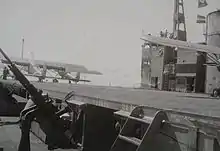Japanese aircraft carrier Akitsu Maru
Akitsu Maru (あきつ丸) was a Japanese landing craft depot ship and escort aircraft carrier operated by the Imperial Japanese Army (IJA). In some sources Akitsu Maru and her sister ship Nigitsu Maru (にぎつ丸) are also considered to be the first amphibious assault ships.[2]
 Akitsu Maru in 1944 | |
| History | |
|---|---|
| Name: | Akitsu Maru |
| Builder: | Harima, Harima[1] |
| Launched: | 24 September 1941 |
| Completed: | January 1942 |
| Fate: | Sunk by USS Queenfish, 15 November 1944 |
| General characteristics | |
| Type: | Aircraft carrier |
| Displacement: | 11,800 tons (standard)[1] |
| Length: | 471 ft 7 in (143.74 m) (pp)[1] |
| Beam: | 64 ft (20 m)[1] |
| Draft: | 25 ft 9 in (7.85 m) (maximum)[1] |
| Propulsion: |
|
| Speed: | 20 knots (37 km/h)[1] |
| Armament: | |
| Aircraft carried: |
|
Design features
Akitsu Maru was a passenger liner taken over before completion by the Imperial Japanese Army. The ship was fitted with a flight deck above the hull, but had no hangar so the aircraft were stored below the flight deck on the original main deck. Conventional aircraft were able to fly off from her deck but could not land aboard due to lack of landing mechanisms, although in July 1944 KX arresting gear was fitted on the flight deck. The Kokusai Ki-76 and Kayaba Ka-1 were flown off Akitsu Maru, as the former was a small, slow aircraft that could land on its short deck and the latter was an autogyro which could even more easily land on a short deck without assistance. She could also carry 27 Daihatsu-class landing craft.
Akitsu Maru's planned role was to provide aircover during amphibious and landing operations; in practice the ship was essentially an aircraft ferry.[3]
Fate
On 18 November 1943 Akitsu Maru, while in company with the torpedo boat Tomozuru, was torpedoed off the entrance to Manila Bay by the United States submarine Crevalle. Crevalle incorrectly reported Akitsu Maru as sunk.[4] With the deployment of the 8,000-tonne (7,900-long-ton) Shinshū Maru and a further refinement, the larger Akitsu Maru, the Japanese amphibious forces had in hand prototypes for all-purpose amphibious ships. In 1937, British and American observers watched Shinshū Maru at work off Shanghai and immediately recognized a significant development in amphibious warfare. The ship carried landing craft in a well deck that could be flooded, which allowed the landing craft to float free from an open stern gate. The ship could also hold additional craft on davits, but its next-most impressive function was an ability to discharge vehicles from a deck-level parking garage directly onto a pier. It also carried two catapults for aircraft but did not embark operational seaplanes. It could, however, transport and unload aircraft if necessary, a capability further developed in the Akitsu Maru, which even had a short take-off flight deck.[5]
Akitsu Maru was sunk by the United States submarine Queenfish on 15 November 1944.[6] There were 2,046 men, mainly of the IJA's 64th Infantry Regiment, who were killed.[7] Her sister ship Nigitsu Maru was sunk by the submarine Hake on 12 January 1944, with the loss of 574 men.[8]

See also
References
- Gardiner; Chesnau. Conway's All the World's Fighting Ships, 1922–1946. p. 213.
- Military innovation in the interwar period. Murray, Williamson., Millet, Alan R. (1st paperback ed.). Cambridge: Cambridge University Press. 1998. p. 81. ISBN 978-1-107-26688-9. OCLC 852896224.CS1 maint: others (link)
- Worth. Fleets of World War II. p. 176.
- Cressman. The Official Chronology of the U.S. Navy in World War II. pp. 193–194.
- Military Innovation in the Interwar Period. Murray, Williamson., Millet, Alan R. Cambridge, UK: Cambridge University Press. 1998. ISBN 978-1-107-26688-9. OCLC 852896224.CS1 maint: others (link)
- Roscoe and Voge. United States Submarine Operations in World War II. p. 416.
- "Japanese Landing Craft Depot Ship".
- "Japanese Landing Craft Depot Ship".
Sources
- Brooks, Peter W. (1988). Cierva Autogiros: The Development of Rotary-Wing Flight. Washington, D.C.: Smithsonian Institution Press. ISBN 0-87474-268-4.
- Cressman, Robert (2000). The Official Chronology of the U.S. Navy in World War II. Annapolis, MD: Naval Institute Press. ISBN 1-55750-149-1.
- Gardiner, Robert; Chesnau, Roger (1980). Conway's All the World's Fighting Ships, 1922–1946. Annapolis, MD: Naval Institute Press. ISBN 0-87021-913-8.
- Roscoe, Theodore; Voge, R. G. (1949). United States Submarine Operations in World War II. Annapolis, MD: Naval Institute Press. ISBN 0-87021-731-3.
- Worth, Richard (2002). Fleets of World War II. Cambridge, MA: Da Capo Press. ISBN 0-306-81116-2.